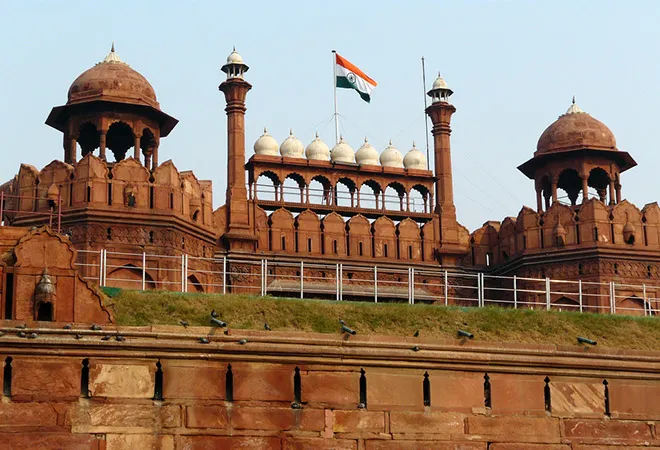Try telling India’s die hard, Left Liberal crowd that a person in desperate need of a public toilet, does not care, whether the plaque above it gives credit to a public-sector company or a private entity. An especially abled person, with a yen for travel, couldn’t give two-hoots who paid for the ramp that makes heritage monuments accessible on her wheel chair.
None of this will wash with those who hold public management of “national” monuments and public sector white elephants dear to their heart. They would rather see them collapse gradually than hand them over to the private sector for making them user friendly.
Last year, in September, the government launched, what should have been an innocuous and much needed initiative to seek non-state (private) interest in providing better facilities at our heritage sites in exchange for on-site advertising. This is explicitly not a revenue generating partnership. No additional fee or charge is to be imposed by the non-state partner.
Things moved surprisingly fast after ex-IAS KJ Alphons got elected to the Rajya Sabha from the BJP and joined the government as minister for tourism. Thirty-one entities have been shortlisted to “adopt” 95 monuments and sites across India.
These entities called “Monument Mitra (friends)” are required to prepare a vision document detailing what needs to be done to improve the visitor experience and how they would go about doing it, as a part of their corporate social responsibility (CSR).
The good news is that, this time around the public-sector has been spared the near compulsory burden of footing the bill. Most of the interested entities are private companies except NBCC (India) ltd. – a construction PSU for the Old Fort, New Delhi and the State Bank of India Foundation for the Jantar Mantar complex, New Delhi.
But the selection which grabbed the headlines was the one signed with Dalmia Bharat Limited for the Red Fort in Delhi. Left Liberal sentiment was outraged at this seeming mortgage of India’s iconic heritage fort, to the Dalmia’s – an old Calcutta/Delhi based family business.
It is unclear, why the Dalmias are interested in the project, except to generate goodwill with the government and amongst citizens in their home city. The potential for getting a free Dalmia promo in the national TV reportage of the annual Independence Day spectacle at the Red Fort on August 15, might have also been a motivator.
The vision document or the MOU, spelling out what the company intends to do has not been publicly shared. The Committees reviewing the expressions of interest; the vision documents and approving the MOUs consist only of the relevant government departments, to the exclusion of non-state actors, particularly from the extended arts, architecture and culture community in Delhi.
As expected, exclusion breeds unnecessary suspicion and distrust. The Modi government seems to shy away from the active participation of non- state actors in decision making. The previous government of Sonia Gandhi-Manmohan Singh went overboard in the other direction, possibly to deflect any blame from itself. A healthy balance between the two extremes would help.
Ramkrishna Dalmia, a Marwari from Rohtak, was the founder of the Dalmia group. Thomas Timberg notes in – “The Marwaris” that, like all entrepreneurs of the early 1900s he made his money from speculation in silver and then went on to become one of the three largest Indian industrialists along with Tata and Birla. But unlike the other two groups, the fortunes of the Dalmia’s have waned.
Dalmia Bharat Cement is a listed company with a market cap of just around Rs 220 billion – around one half of the smallest 100 top listed BSE companies. Its CSR focus is on energy conservation, rural development and solar power applications. Providing and managing visitor facilities for a significant historical monument is a significant departure from its main line of business. Of course, that is no reason to dismiss the effort outright. But it does raise doubts about their ability to perform, to satisfaction, even if the intent is genuine.
Government argues that corporates are not exactly lining up to spend scarce money on historical monuments. They must make do with those who are interested, even if they will have a steep learning curve. Mechanisms for technical support to the Monument Mitra and oversight of their activities, are being put in place. Cultural czars however, thumb their noses at such amateurish attempts to break into the rarified world of culture, art and heritage architecture.
To be fair to the government, not all selections, have the same problem. The well-known Aga Khan Trust – which restored Humayun’s Tomb in New Delhi, has been selected for the Aga Khan Palace in Pune; The premier hotel chain ITC and a GMR entity (builders of the Delhi airport) have been selected for the Taj Mahal and so on.
Dalmia Bharat Limited – a cement manufacturer and infrastructure developer – is an outlier for the Red Fort. One wonders why the government does not share the rationale on which the decision was made with interested citizens. This would allay fears.
Suspicion of the Bania (India’s mercantile caste) is deeply imbedded in the Indian psyche, possibly anachronistically. Even the Marwaris and Banias might have moved on from the rapacious image that Left Liberals have of them. We shall know soon enough. By Independence Day, August 15, 2018.
This commentary originally appeared in The Times of India.
The views expressed above belong to the author(s). ORF research and analyses now available on Telegram! Click here to access our curated content — blogs, longforms and interviews.




 PREV
PREV


